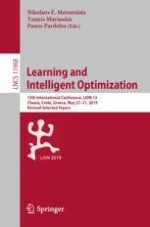2020 | Book
Learning and Intelligent Optimization
13th International Conference, LION 13, Chania, Crete, Greece, May 27–31, 2019, Revised Selected Papers
Editors: Prof. Dr. Nikolaos F. Matsatsinis, Dr. Yannis Marinakis, Prof. Panos Pardalos
Publisher: Springer International Publishing
Book Series : Lecture Notes in Computer Science
